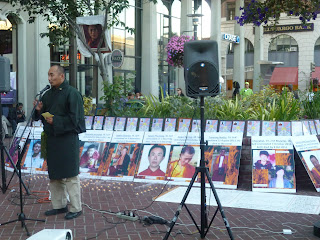བོད་ཀྱི་སྐད་ཡིག་བདག་གཅེས།
བྱང་ཨ་རིའི་བོད་རིགས་སློབ་གྲྭའི་བོད་དགེ་ལྷན་འཛོམས་ཚོགས་འདུ་ཐེངས་དང་པོ། ༢༠༡༢ སྤྱི་ཟླ་ ༨ ཚེས་གྲངས་ ༢༥ དང་ ༢༥ ཉིན་གཉིས་རིང་བསྐྱངས།
བྱང་ཨ་རིའི་བོད་རིགས་སློབ་གྲྭའི་བོད་དགེ་ལྷན་འཛོམས་ཚོགས་འདུ་ཐེངས་དང་པོ། ༢༠༡༢ སྤྱི་ཟླ་ ༨ ཚེས་གྲངས་ ༢༥ དང་ ༢༥ ཉིན་གཉིས་རིང་བསྐྱངས།
Tibetan Language Teachers' Conference cum Workshop Held in San Francisco Bay Area, California. August 26, 2012 Sunday
San Francisco Bay Area: The First North American Tibetan Language Teachers' Conference organized by Tibetan Association of North California (TANC) from August 25 to 26, 2012 at the community hall concluded successfully with a great sense of unity and fulfillment among the participants. The conference was organized with a view to discuss the hope and challenges of imparting Tibetan language and culture to the youngsters, and to find a central unified system of teaching Tibetan language in the region. The conference was made possible through the sponsorship of Walter & Elise Hass Fund.
Chief guests of the conference were Mr. Tashi Namgyal, Tibetan Parliament member of the reigon; Mr. Tsewang Phuntsok, Representative from the Office of Tibet, New York; and Mr. Tenzin Namgyal Tethong, Ex Kalon Tripa of Central Tibetan Administration, Dharamsala. Frances from the Walter & Elise Hass Fund also attended the opening ceremony. There were Professors and lecturers from American universities, and educators and teachers from Tibetan schools in North America. Many observers and parents also participated in the conference. Mr. Tenzin Tsedup, Chairman of the Tibetan Association greeted and welcomed the guests and the participants. In his opening speech he spoke on the importance of preserving and promoting Tibetan language, and to discuss ways and means to practically teach the language to our youngsters in this new environment.
The Chief guests Kazur Tethong la and Chitue Tashi Namgyal la welcomed the initiative, and requested the participants to take full use of this platform to establish a practical and effective curriculum to benefit our youngsters to enable them to bloom in American society with strong solid Tibetan root and background. Gen Ugyen la of Tibetan School in Bay Area coordinated and moderated the proceedings.
On the first day, Tibetan professors and lecturers in American universities made presentations and spoke on the effective way of teaching ones native language along with the mainstream language. They are: Nangsel Tenzin Norbu la from Columbia University, Tseten Chojor la from Virginia University, Tsering Wangchuk la from San Francisco University, and Tenzin Dorjee la from Fullerton University. Leslie Hite from Immersion; and Myrna Shadley from First-Five spoke on the importance of educating the child in bilingual atmosphere, and how most of the immigrants have been coping and making success in this multi-lingual, multi-cultural nation.
On the second day, Karma Ngodup la of Chicago University gave an extensive presentation on school curriculum, and how best to adopt modern technology in teaching the language to the children. Phurbu Thakchoe la of Tibetan school in Bay Area talked on the current situation and challenges of teaching the language in foreign environment. Teacher participants from some eight regions talked of their experience of teaching the language, and interacted with the resource persons and sought their guidance. Later, the participants discussed the language teaching issue in two groups and submitted their respective resolutions to the committee.
Essence of the discussion and the workshop have made the participants realize that it is not the teaching of the language that is important, more than the teaching, it is how we could arouse the interest of our youngsters in learning the language. One of the resource persons remarked, "It is not teach, teach, teach, it is care, care, and care". It is only through proper care that we could get our children learn our culture, and the most important factor is the parents' participation and their enthusiasm. We cannot ignite the interest of our children in our culture if the parent themselves are not interested in it. One of the teachers said, "Sad thing is there are Tibetans who take pride in not being good in Tibetan language, and for forgetting the language. These parents should think twice before they make such remark."
The participants were unanimous in the decision that interest of the child should be taken priority, language should be taught interestingly using play method, storytelling, Tibetan folk stories, fun reading, song and dance etc. A ten-point resolution was drafted and read before the participants and the audience at the end by Tsewang Phuntsok la of Office of Tibet.
Gist of the resolution is: Establishment of uniform curriculum for each language class or grades and the committee responsible for creating the text books; Use of Uchen in early stage to make it more contextual learning; Central language teaching guidance website and annual language teacher workshop by Office of Tibet, New York; Implementation of resolutions made at Michigan conference in 2008; Next language conference to be organized by New York and New Jersey Tibetan Association. For detail resolution, please visit here http://tancconference2012.weebly.com
The conference was a great success, and many expressed satisfaction for being able to participate and get guidance in this important task of preserving and promoting our language and culture. Some participant suggested that there should be language class for adult Tibetans also. Participants have come from New York, New Jersey, Ithaca, Washington, Boston, Seattle, Oregon, New Mexico and San Francisco. Tibetan Association's hall remained fully packed for two days during the conference cum workshop, it gave the Tibetan scholars, teachers, and the general public a strong sense of oneness and renewed energy and fervor to preserve and promote this sacred ancient bond of our unity and strength, Tibetan language and culture.
+012.jpg)





